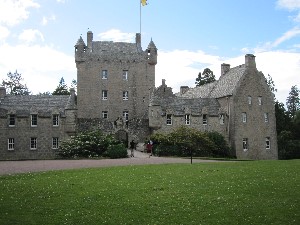|
Marriage in the Western Highlands in the Early 1500's*
The most surprising thing I learned in my research for my THE RETURN OF THE HIGHLANDERS series was about the marriage practices of Highlanders in the Western Isles, particularly the chieftains, during the time my books take place.
In the early 1500's, these Gaelic-speaking Highlanders maintained their old Celtic customs alongside their Christian beliefs. Priests were not necessary to make a marriage, which was fortunate since priests were few and far between. In Celtic secular marriage, it was common for couples to enter a trial marriage. At the end of a year, either party could leave the marriage. If the couple decided to stick with it, they often had their marriage blessed at the same time their first child was christened when the priest made his rounds. Children born of these trial marriages were considered legitimate, and men generally claimed children born outside of marriage as well. Divorce was permitted by either party on fairly loose grounds.
Chieftains, who were more than kings to their clans, disregarded edicts from Rome as freely as they ignored edicts from the Crown. For them, marriage was a means of making an alliance with another clan-and they changed alliances all the time. Henry VIII had nothing on some of these chieftains when it came to multiple wives, though a chieftain could simply "set aside" a wife, rather than look for an excuse to have her killed.
The chieftains did not ignore the Church rules entirely, but Rome was a long way away so they generally followed the principle that it was better to ask forgiveness than permission. Though a chieftain might seek a formal annulment, he was unlikely to wait the two or three years to get an answer from Rome before taking a new wife. The petition for annulment was often based on the marriage being in violation of the rules of consanguinity, though everyone had been well aware of the issue at the time of the marriage.

Dunscaith Castle, home of MacDonald of Sleat chieftain.
As might be expected, a clan chieftain's serial (and sometimes concurrent) marriages did not always lead to family harmony or good relations with other clans. The MacDonalds of Sleat, the clan of my fictional heroes, had more than their share of such conflict.
Hugh (Uisdean), the first MacDonald of Sleat and the grandfather of my fictional character Connor, was one of three sons that Alexander, the third Lord of the Isles, had by different women. Despite being admonished by the pope himself for putting away his true wife and "adhering" to Hugh's beautiful and highborn mother, Alexander refused to part with her. His half-sons, however, got along well.
Hugh had six sons by six different women, all from prominent families. Unfortunately, his sons did not get along as well as Hugh and his brothers had. In fact, Hugh's first son hated his half-brothers so much that upon his death he turned the clan's lands over to the Crown to prevent the others from inheriting them. Though later chieftains held onto the lands, their lack of legal title caused the clan problems for years. Two of Hugh's other sons were murdered by their half-brothers, and another was murdered by Hugh's grandsons.
This family strife plays an important role in all four books of THE RETURN OF THE HIGHLANDERS. In THE SINNER, I also included as secondary characters two real historical couples who married to make alliances between their respective clans-with wildly differing results.
I drew on a well-known incident involving the Maclean chieftain, Lachlan Cattanach (Shaggy), and his wife Catherine, whose father and then brother were chieftains of the powerful Campbell clan. I won't say here what happened, but when Shaggy was found murdered in bed on a visit to Edinburgh some years later, everyone assumed it was done by a Campbell in retribution.

Cawdor Castle, Muriel's home.
Catherine's brother John had better luck in marriage. When the Thane of Cawdor died leaving his baby daughter Muriel as his sole heir, clan chieftains all over the Highlands hoped to arrange a match when she came of age that would result in one of their sons becoming the next Thane of Cawdor. When Muriel was still a toddler, the Campbell chieftain preempted the others by having his men snatch Muriel while she was outside the walls of Cawdor Castle taking in the fresh air with her nursemaid. Muriel was raised in the Campbell chieftain's household and married to John as soon as she reached twelve, the age of consent. By all reports, this marriage, which was made for the sole purpose of gaining lands and wealth for the Campbells, was a very happy one.
Then as now, some marriages turn out well despite how they started.
* My primary source is "Marriage, Concubinage and Divorce in Gaelic Scotland," by David Sellar, from Volume 51 of the Transactions of the Gaelic Society of Inverness, though any mistakes are mine. (Thanks to Sharron Gunn for referring me to the article.) I also found supporting information in clan histories from numerous sources.
© Photos & article by Margaret Mallory
|